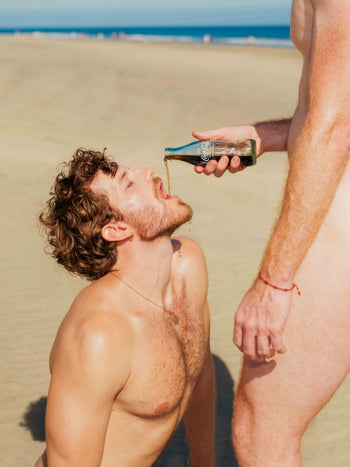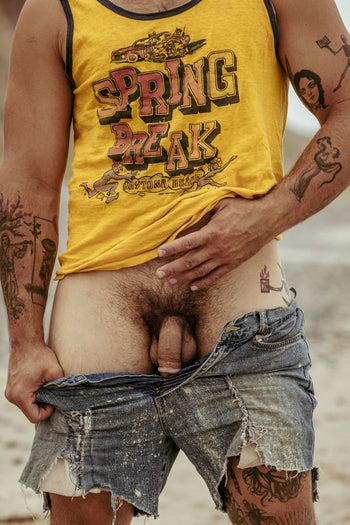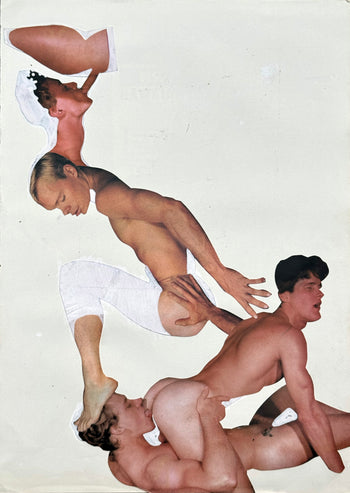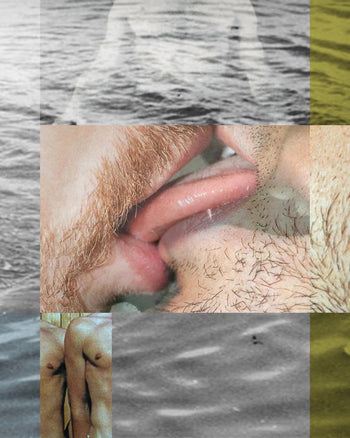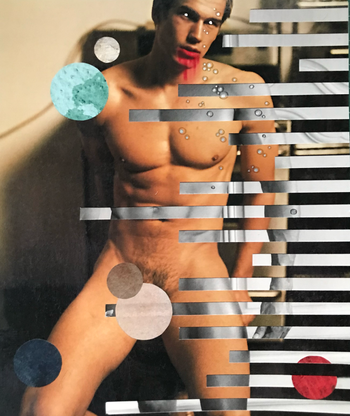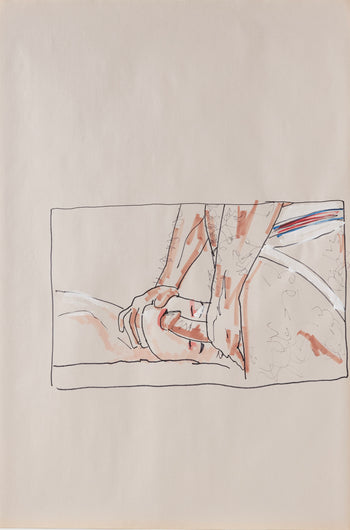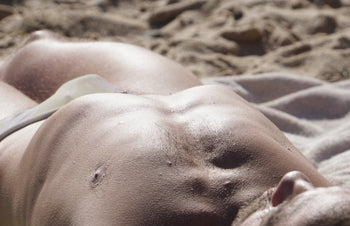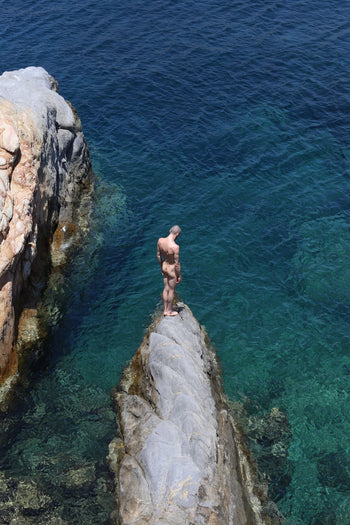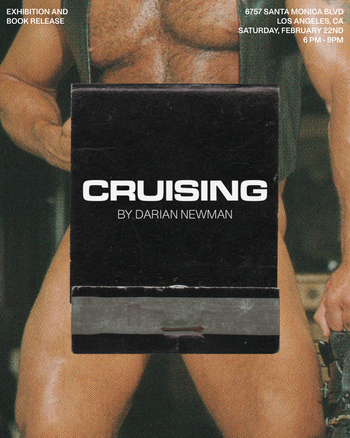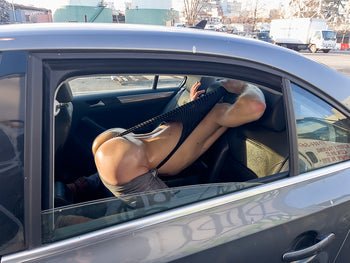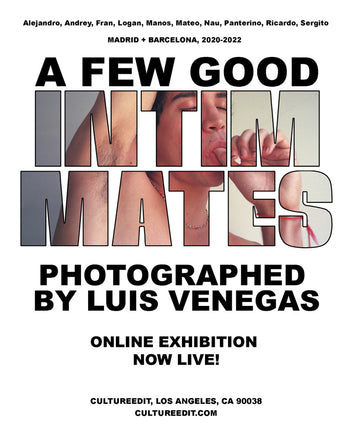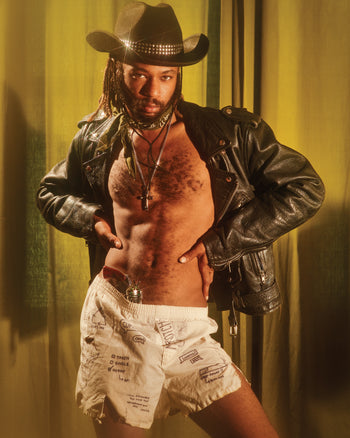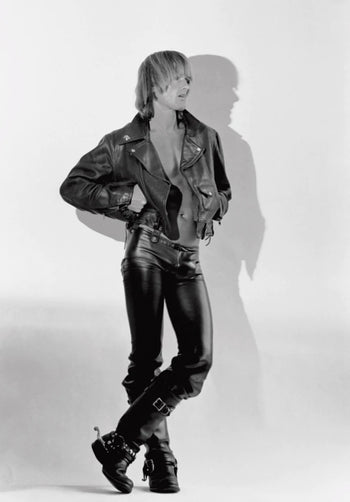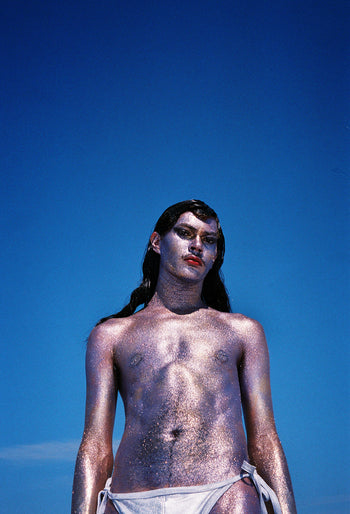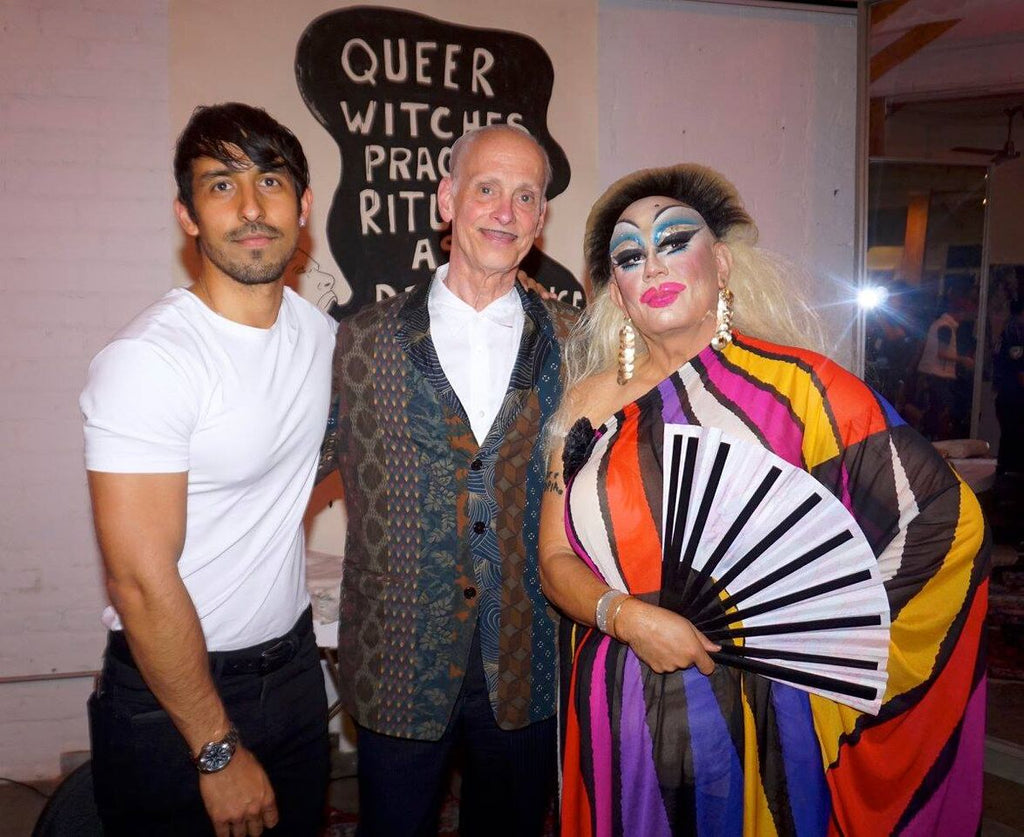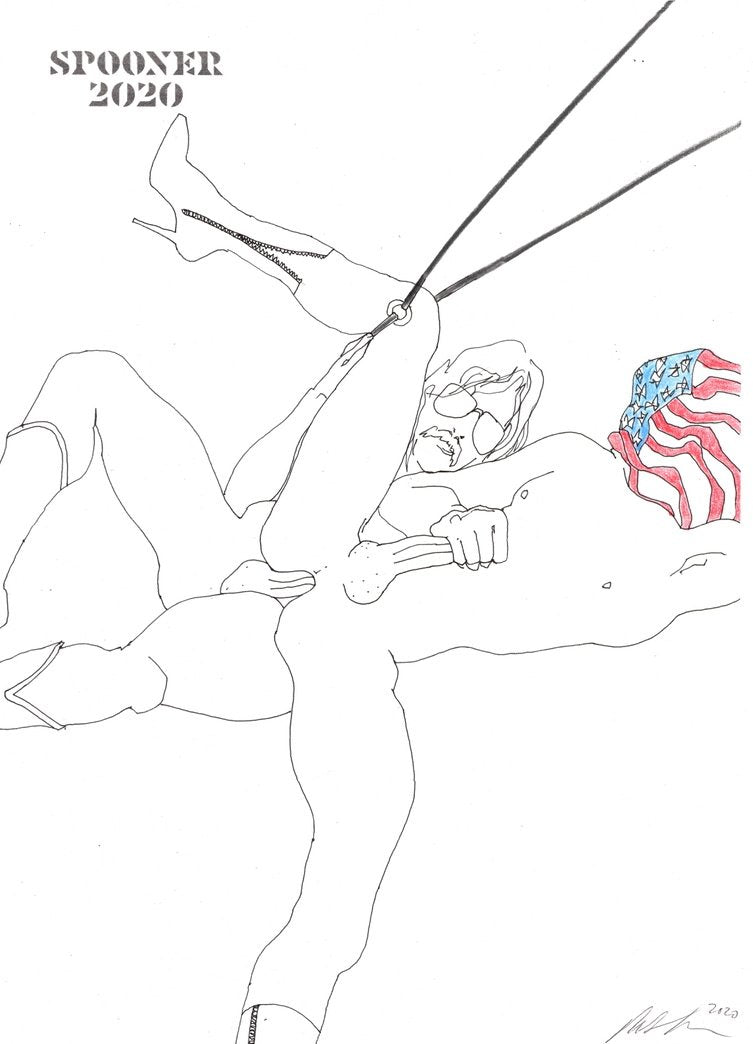So you started work on Queer Biennial 3 once QB2 finished in 2016?
Immediately after the 2016 iteration, I started coming up with ideas. I wanted to get super political, but when I talked to our new chief curator— I needed some help— Nico said, I don’t want to do anything political because by the time of the show we’ll be exhausted.
Trump had been elected...
Trump had been elected president. And I thought, I am going counter the early show about the AID’s scourge [QB2], and do something that’s positive and wonderful. I thought, What is Utopia?, or What if Utopia. I checked with the other curators and everyone was on board. Then we started inviting artists and dropping that seed (in a very blanket, abstract way) to see if any of the artist really followed up on the theme.

Before we get into art, I want to know first— at what point did you decide to bring on other curators? The last two were all you, but this iteration was huge! At what point did you form a team?
I knew the show was naturally gonna get bigger, but I didn’t know it was going to get this big this fast. If we were going to make it into a larger venue and really look into international artist, we needed more hands. We also wanted to touch on the spectrum. We didn’t want to only have American artists because it’s an international affair.
Can you say how many countries and artist are represented, for the interview?
This year we were looking at Mexican artists because Nico and I love Mexico and we travel to Mexico and we’re both part Mexican. Also, he lived in Israel and is well connected with the Israeli consulate and artists, so that’s how it happened. We also have a lot of European and of course, American artists. There are 20 countries represented, and over 100 artist in the show.

Do you feel the artists responded to, What if Utopia? Does the show represents that?
I was having a conversation with someone who feels like some of the art is dystopian, and I was explaining to them that a lot of us queer folk come from damaged places in our childhood, and it somehow is reflected in that; some of us find comfort in a dark shiny place. There’s a certain beauty in that. I preface every studio visit with saying, “this is not my exhibition, it’s your exhibition, it’s your work.” So if you tell me it’s about “fuck you” and wanna do dark shiny dystopian imagery, that’s perfectly fine. I don’t art direct. We selected artist who had utopian imagery, but we also invited artist that were investigating other themes to explore a utopian take on their work. What is Utopia anyway? It varies from person to person. It’s not always blue sky and butterflies. Utopia can mean different things.
I love that. John Waters was at the opening! Let’s talk about him.
Oh yes!
So he was the keynote speaker at the opening. I know Nico had worked with him before—
Nico had worked with him before at the Luckman. The timing was wonderful because he was set to come June second. We asked him, “Would you be interested in coming to see us, and maybe saying a few words?” and he said, “Of course! I’d love to.” You have to remember John comes from the queer world… the underworld… from these kind of lovely disjointed people. So he was lovely about it.
I noticed when the room was packed full and everyone was in their crazy outfits and drunk— he really handled the crowd. He didn’t seem flustered at all to be addressing such a motley crew, and all the noise—
I have to tell you, he’s nothing but a gentleman, and very sweet. He shared that one of his aversions is assholes, and that’s one of my aversions, too. So that’s why we’re simpatico, because I hate assholes… Anway, Nico asked me to interview him, and I’m not really a front of house kind of—

You were dressed as Divine! The Latina Divine…
That was my security blanket! I told Nico, “I think you should interview him, because you’re the new kid and you brought him, you ask him the questions.” And he said, “No no, no fucking way. You have to do it because you started this whole thing.” I said, “Oh, Okay. Great!”
I love the collaboration that you two have.
Yeah, it’s almost like we’re a married couple. We don’t speak. We just understand stuff… So he asked me to interview John Waters, and I fretted. I decided, I’m gonna become another person. I’ve done drag (or become other personas), so I thought, I’m gonna do divine, but my own version of divine… La Di..Which is divine in spanish… I became La Divina House of Ninja and got nothing but great love vibes from John. He’s very prepared, very professional, which is nice to see… What else do you wanna know?
Hah! Okay… For someone who’s approaching the show for the first time: are there any standout pieces, anything really notable, or that you love about the show?
You know, there’s different curators that curate different things:

Nicholas Alexander Milos Mestas, our chief curator.
Stuart Sandford, curator in charge of film.
Mark Tennyson, in charge of performance.
Steven Reigns, Literary Arts.
and Ilona Berger, curator and director of Last Projects.
Michael Holt, Curator and Co-Founder of Navel (the space).
Yelena Moskovich, our Paris Curator and Carlos Morales Rabago, our advisor from Mexico City.
For the most part, I concentrate on what I call pretty pictures. The stuff that’s on the walls— cause I come from the world of painting and drawing, which I love— I don’t come from the land of performance, but if you’re going to have a queer biennial you need to have all the disciplines.
Some of the standouts are things that I didn’t expect to see. Like these wonderful Israeli artists like Gil Yefman, who did the Hitler sex doll, which perfectly illustrates the dystopian thing. Like in the conversation about dystopia vs utopia from earlier, I said, “Can you imagine having an Adolf Hitler sex doll? Imagine fucking or fisting him until his guts fell out? Wouldn’t that be lovely?” I know it’s dark, but to me, it sounds like a lovely utopia. So Gil is great. Same with Adi Nes, also israeli… Some of the Mexican artist… I love Santy Mito, he does these beautiful formal settings with brown people and flowers in different settings. Nicki Green is great, she does these beautiful marble ceramics that go beyond the decorative— the whole idea is that, as a director, I pay attention to touch on the spectrum; the spectrum in terms of gender, age, ethnicity… because if we’re really talking about queer culture we need to cover all the communities, there’s not one community. And so that’s very important to us.
It’s amazing, you speak about the spectrum, and the show is diverse even in the artistic visions of utopia.
The reason I started the queer biennial, way back in 2012, is because I’d go to art openings and galleries— the joke is: run by, for, and in collaboration with 35-year-old white men. Well I had a lot to say about that, but I thought, shut the fuck up and do something about it. I wanted to do this humble little thing with a lot of heart and soul, and if people saw that, they’d want to get involved. That’s how we got all these other curators. Because they saw it was important for us to cover the spectrum. And there’s not another Queer Biennial.
So you’ve created the queer biennial empire. You brought Nico on this year, you’ve talked about passing on the torch… What is the future? What is the torch?
I mean… this was ten thousand times greater than what I expected, thanks to Nico Mestas (Chief Curator) and all the other curators involved!

It was amazing! It was lines out the door, amazing crowd, amazing energy, amazing response…
There were lines around the building! In the adrenaline rush and the excitement I asked Nico very shyly if he’d be willing to do it again in two years. He answered yes with an exclamation point and I said, “Sweet Joy!” Those are my words for this. Sweet Joy. (And Mija, everyone is going to be Mija.) I talked to Michael Holt about it— you know the show is still going on— and he said, we need to go global. So we’re regrouping after the show, and then we’ll see what we’re gonna do. I kinda have an idea that it’s gonna be a yin yang type of thing, like exaltation and revulsion, hot and cold, dark and light… duality, but I don’t know. I’m developing the idea and will need to discuss it with the future curators, of course.
As someone who’s done three queer biennials now, who is constantly meeting new artist and fresh voices, what changes have you noticed? There’s this idea that queer culture is being absorbed by the mainstream and disappearing. What’s your thought on that?
I think that queer culture is coming into the fold of the general overarching culture, but what’s going to happen I feel— and it think it’s very important to continue the QB and continue being queer and to keep this punk attitude— what happens is the dominant culture absorbs, and then all the sudden we are so watered-down that we forget we come from a line of outsiders with pees and vinegar ready to shake things to its core. The reason we can have a Queer Biennial downtown and show a Hitler sex doll is because we rioted, and yes, we had allies, but we still have to keep our culture. It is important to keep that lineage. This is why I started the Queer Biennial. And not just for that, but to touch on the spectrum. Queer folk is not all white folk, it’s not all 35-year-old men, it’s everybody. It’s brown people, it’s jewish people, it’s a twelve year old that’s a drag queen, and it’s some old guy in the closet who steps out once in a while. That’s what it is.

Queer Biennial is running the entire month of June. For specific events and details visit queerbiennial.org
Jamison Karon is the author of How to Be a Faggot, and creator of the series and short film Sorry You're Sad. He is a screenwriting fellow at the American Film Institute.

